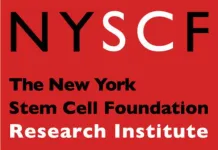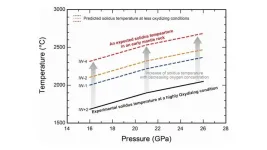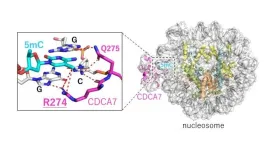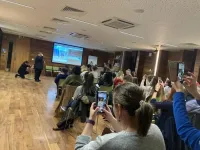(Press-News.org) COLLEGE PARK, Md. – Who hasn’t sat in a medical office, listening to computer keys clacking while their provider rapidly types up notes, wondering what they are spending so much time writing about? For doctors, who have always written clinical care notes but increasingly must spend time cataloging billing details, this additional documentation is a major source of job dissatisfaction and burnout. A new study out today by University of Maryland’s School of Public Health illuminates a solution that can meaningfully reduce the amount of time doctors spend writing notes, without losing vital information.
“Providers are already stretched thin and under intense pressure to see more patients all while documenting large amounts of information. So we looked at how using medical scribes and other forms of teamwork for documentation can reduce that burden,” says Nate Apathy, assistant professor of Health Policy and Management. Apathy’s current research focuses on sources of technology-based burden in health care and strategies to reduce it.
Apathy’s study, “Physician EHR Time and Visit Volume Following Adoption of Team-Based Documentation Support”, was published today in JAMA Internal Medicine with collaborators from the University of California, San Francisco, and the University of Minnesota. The results show that collaborating on clinical documentation with other team members can help give doctors and other providers more time to spend on patient care. In this study, “team-based documentation” refers to scribes or other clinicians contributing to clinical notes, whether in the room or connected virtually, but does not include AI scribes.
The longitudinal study considered documentation practices and weekly visit volume of more than 18,000 outpatient doctors - mostly primary care physicians and some medical and surgical specialists - across more than 300 health care organizations across the United States over a 9-month period. Of this total, 1,024 doctors adopted some kind of teamwork for clinical note-writing.
“We found the vital thing is not just having teamwork for documentation, it is how much the non-physician collaborators are doing,” Apathy said.
Of those providers using scribes and other forms of documentation collaboration, all of them were able to increase their volume of weekly patient visits. But only those whose teams wrote at least 40% of their note content actually reduced the doctor’s time spent writing notes.
On average, visit volume increased by 6% and documentation time decreased by 9.1%. After a 20-week learning period, visit volume increased by 10.8% and documentation time decreased by 16.2%. For high-intensity adopters (those who had others write more than 40% of their notes), weekly documentation time went down by more than an hour (28.1% decrease), a relatively large time savings.
“Our research shows that when doctors use teamwork to complete their notes, whether that’s with a medical scribe in the room, a virtual note-taking service, or just shared note-writing with other clinical team members in their offices, they can see more patients and, crucially, spend significantly less time with their nose in a computer,” says Apathy.
For every visit, providers must complete clinical notes that contain everything from a patient’s vital signs to test results to insurance billing data. While some of these notes are essential in tracking a patient’s health, spending time on administrative documentation to ensure insurance companies pay the bills is an especially heavy burden and can have implications for quality of care.
Doctors generally report that they frequently have to catch up on notes after hours or in between appointments, adding more stress and work hours to an already overloaded occupation. The scribe can be a lifeline, especially when used sufficiently.
This study is the first to examine the real-world impact of medical scribes at such a scale. Apathy says innovations like virtual scribes are popular among primary care physicians because they are relatively cheap and easy to implement and scale, and the cost of a scribe can be offset with the increased income from more patient visits.
Even outside of the COVID pandemic, healthcare workers report high levels of stress and burnout, more than most other industries.
“So it’s a triple win – for managing the business side of a clinic, for a health system with a huge demand from patients and a major shortage of providers, and for easing the administrative workload of already overburdened doctors,” Apathy said.
END
Sharing expands caring – UMD study finds solution to a major source of doctor burnout
Scribes can help doctors do less paperwork, more patient care
2024-08-26
ELSE PRESS RELEASES FROM THIS DATE:
Human stem cell models point to glia as key players in multiple sclerosis
2024-08-26
NEW YORK, NY (AUGUST 26, 2024) — A team of scientists from The New York Stem Cell Foundation (NYSCF) Research Institute and Case Western Reserve University has created the largest reported collection of stem cell models from multiple sclerosis (MS) patients and used them to identify unique ways in which glia – integral support cells in the brain – contribute to the disease.
The study, published today in Cell Stem Cell, is the first to report that glial cells from MS patients have intrinsic hallmarks of disease, independent of immune system influences, which points to the power of stem cells for revealing new disease biology and to the need for ...
Uncovering the role of oxygen concentration in the formation of early earth magma ocean
2024-08-26
It is widely accepted that the early Earth largely consisted of molten magma, forming a global ocean of magma. This extreme state of Earth was likely caused by the intense heat generated from accretionary impacts, meaning the collision of smaller celestial bodies with Earth. Understanding the formation of this magma ocean is crucial for comprehending Earth’s formation. A major problem with current magma ocean formation models is the lack of consensus on the melting temperatures of deep mantle rocks. Models explaining Earth’s core formation use a specific ...
Early galaxies were not too big for their britches after all
2024-08-26
When astronomers got their first glimpses of galaxies in the early universe from NASA’s James Webb Space Telescope, they were expecting to find galactic pipsqueaks, but instead they found what appeared to be a bevy of Olympic bodybuilders. Some galaxies appeared to have grown so massive, so quickly, that simulations could not account for them. Some researchers suggested this meant that something might be wrong with the theory that explains what the universe is made of and how it has evolved since the big bang, known as the standard model of cosmology.
According to a new study in The Astrophysical Journal led by University of Texas at Austin graduate student ...
SwRI showcases latest warfighter research at military health research symposium
2024-08-26
SAN ANTONIO — August 26, 2024 — Southwest Research Institute will highlight its capacity to advance military medicine and human performance at the Military Health System Research Symposium, August 26-29, in Kissimmee, Florida.
“Southwest Research Institute has a long history of working with several DOD agencies,” said Senior Research Engineer Kreg Zimmern of SwRI’s Chemistry and Chemical Engineering Division. “SwRI offers multidisciplinary expertise, allowing us to manage government contracts ...
Scientific consensus can strengthen pro-climate attitudes in society
2024-08-26
Climate scientists have long agreed that humans are largely responsible for climate change. A new study, co-led by Bojana Većkalov from the University of Amsterdam and Sandra Geiger from the University of Vienna, finds that communicating the scientific consensus about climate change can clear up misperceptions and strengthen beliefs about the existence and the causes of climate change. The team surveyed over 10,000 people from 27 countries on 6 continents. The study has just been published in the renowned journal Nature Human Behaviour.
Scientific consensus identifying humans as primarily responsible ...
Unraveling the role of CDCA7 in maintenance of DNA methylation
2024-08-26
DNA methylation, a process by which methyl groups are added to DNA molecules, is essential for the maintenance of DNA and the overall health of an organism. Disruptions in the standard DNA methylation patterns can lead to immunodeficiency and diseases such as cancer. Helicase lymphoid-specific (HELLS) is an enzyme that facilitates DNA methylation by remodeling the nucleosome - the tightly packed structure of DNA wound around histone proteins. The absence of HELLS or its activator, cell division cycle associated 7 (CDCA7) is known to be a factor that leads to the disruption of DNA methylation. Mutations in the genes that code for HELLS and CDCA7 cause rare disorder immunodeficiency, ...
Study finds salamanders are surprisingly abundant in northeastern forests
2024-08-26
RESTON, Va. — Two recent amphibian-focused studies shed light on the ecological importance of red-backed salamanders, while confirming that proactive measures would prevent costly impacts from a wildlife disease spreading across Europe that has not yet reached North America.
Scientists knew that red-backed salamanders were abundant in eastern North America, but a recent study found their densities and biomass across the region were much higher than expected. The study authors estimated an average of ...
Old chemo drug, new pancreatic cancer therapy?
2024-08-26
The fight against cancer is an arms race, and one of the most effective weapons in clinicians’ arsenals is immunotherapy. Immune checkpoint therapy has become the standard for treating several types of cancer. However, the Nobel Prize-winning strategy is ineffective for most pancreatic ductal adenocarcinoma (PDAC) patients.
“Immune checkpoint therapy is only an option in rare cases of PDAC,” Cold Spring Harbor Laboratory (CSHL) Professor Douglas Fearon says. “It’s only effective for patients with a specific subtype of PDAC—that’s less than 5% of all cases.”
Until recently, it was thought that PDAC didn’t ...
Shakespeare in sign language, seen through AI
2024-08-26
A new study uses co-creation with reference communities to develop an app for sign language machine translation (SLMT). The research team designed a theatrical performance in sign language, seen through the eyes of artificial intelligence (AI), as one of the methodologies. “Historically, deaf people have been excluded from the development of automatic translation technologies,” says Shaun O’Boyle, Research Fellow in the School of Inclusive and Special Education (Dublin City University DCU). “This has often caused backlash and resistance from deaf communities, as the projects were designed and ...
PLOS and the University of South Carolina announce APC-free Open Access publishing agreement
2024-08-26
SAN FRANCISCO — The University of South Carolina and the Public Library of Science (PLOS) today announced a three-year Open Access agreement that allows researchers to publish in PLOS journals[1] without incurring article processing charges (APC). This partnership brings together two organizations that believe researchers should be able to access content freely and make their work available publicly, regardless of their access to funds.
“The evidence is undeniable — open research enables the convergence of ...
LAST 30 PRESS RELEASES:
Numbers in our sights affect how we perceive space
SIMJ announces global collaborative book project in commemoration of its 75th anniversary
Air pollution exposure and birth weight
Obstructive sleep apnea risk and mental health conditions among older adults
How talking slows eye movements behind the wheel
The Ceramic Society of Japan’s Oxoate Ceramics Research Association launches new international book project
Heart-brain connection: international study reveals the role of the vagus nerve in keeping the heart young
Researchers identify Rb1 as a predictive biomarker for a new therapeutic strategy in some breast cancers
Survey reveals ethical gaps slowing AI adoption in pediatric surgery
Stimulant ADHD medications work differently than thought
AI overestimates how smart people are, according to HSE economists
HSE researchers create genome-wide map of quadruplexes
Scientists boost cell "powerhouses" to burn more calories
Automatic label checking: The missing step in making reliable medical AI
Low daily alcohol intake linked to 50% heightened mouth cancer risk in India
American Meteorological Society announces Rick Spinrad as 2026 President-Elect
Biomass-based carbon capture spotlighted in newly released global climate webinar recording
Illuminating invisible nano pollutants: advanced bioimaging tracks the full journey of emerging nanoscale contaminants in living systems
How does age affect recovery from spinal cord injury?
Novel AI tool offers prognosis for patients with head and neck cancer
Fathers’ microplastic exposure tied to their children’s metabolic problems
Research validates laboratory model for studying high-grade serous ovarian cancer
SIR 2026 delivers transformative breakthroughs in minimally invasive medicine to improve patient care
Stem Cell Reports most downloaded papers of 2025 highlight the breadth and impact of stem cell research
Oxford-led study estimates NHS spends around 3% of its primary and secondary care budget on the health impacts of heat and cold in England
A researcher’s long quest leads to a smart composite breakthrough
Urban wild bees act as “microbial sensors” of city health.
New study finds where you live affects recovery after a hip fracture
Forecasting the impact of fully automated vehicle adoption on US road traffic injuries
Alcohol-related hospitalizations from 2016 to 2022
[Press-News.org] Sharing expands caring – UMD study finds solution to a major source of doctor burnoutScribes can help doctors do less paperwork, more patient care










